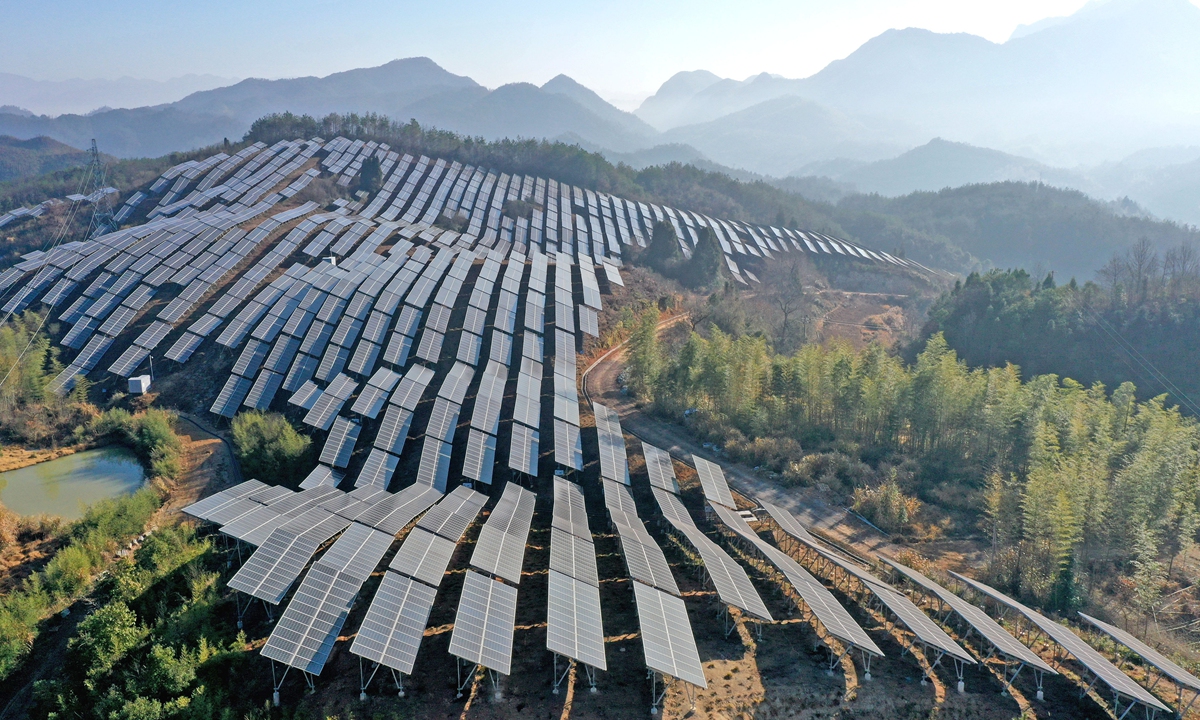China's 2024 energy strategy aims to boost green transition, ensure energy security

A photovoltaic (PV) power station on a barren mountain in Xianju county, East China’s Zhejiang Province, delivers green energy on January 8, 2023. Photo: IC
China's National Energy Administration (NEA) released its 2024 energy work plan on Friday, laying out a roadmap aimed at bolstering the green and low-carbon transition of the country's energy sector while boosting energy security.
The NEA set a target to secure China's energy supply at about 4.98 billion tons of standard coal equivalent for 2024. It also outlined strategies for maintaining stable coal production growth, keeping crude oil output above 200 million tons, and achieving a rapid increase in natural gas production. The plan also forecast that the total installed power generation capacity will reach around 3.17 billion kilowatts, with electricity generation expected to reach approximately 9.96 trillion kilowatt-hours.
Key to the NEA's strategy is optimizing China's energy structure, with an ambition to raise the installed capacity of non-fossil fuel energy to around 55 percent of the total capacity. Wind and solar power are projected to contribute over 17 percent to the national electricity supply, and natural gas will reach about 18.9 percent in the total energy consumption mix.
Highlighting energy security as a key area, the guidance underscores the necessity of ensuring uninterrupted energy supply throughout the green transition, Lin Boqiang, director of the China Center for Energy Economics Research at Xiamen University, told the Global Times on Friday. It's vital to maintain energy security in order to prevent shortages during the transition period, Lin noted.
The document specifies several key initiatives to reinforce energy security, such as prioritizing energy security as a cornerstone of high-quality development, enhancing oil and gas production, ensuring a reasonable surplus capacity for coal, increasing strategic reserves, and boosting regional cooperation to fortify the foundations of energy security.
While the guidance underscores the continued relevance of traditional fossil fuels through increased exploration and production efforts, it equally stresses the importance of advancing high-quality development in non-fossil energy sectors. This includes accelerating the construction of large wind and solar power bases, promoting the development of solar thermal power, speeding up distributed wind and photovoltaic power generation, and progressively advancing hydropower and nuclear power projects.
Lin pointed out that reducing costs, especially those associated with ensuring system stability, is central to the energy transition. Despite the advances in China's wind and solar industries, developing traditional thermal power and energy storage technologies is still essential for stability.
The NEA also aims to transform energy consumption patterns in line with the clean and low-carbon development trend, intensify the substitution of clean and low-carbon energy, and drive energy-saving, pollution reduction, and carbon reduction in the energy sector. Furthermore, the strategy calls for the promotion of a green and low-carbon lifestyle and production modes and advancing energy technology innovation.
China's strides in both traditional and renewable energy sectors have been notable. On Monday, Chinese state-owned oil giant CNOOC announced the discovery of a major oilfield in the Bohai Sea with proven reserves of 104 million tons of oil, marking a monumental find in the region following a decade of search efforts.
By the end of 2023, renewable power generators' capacity exceeded half of China's total power generating capacity, and the production and sales of new-energy vehicles surged to 9.587 million and 9.495 million, respectively, marking year-on-year increases of 35.8 percent and 37.9 percent.
